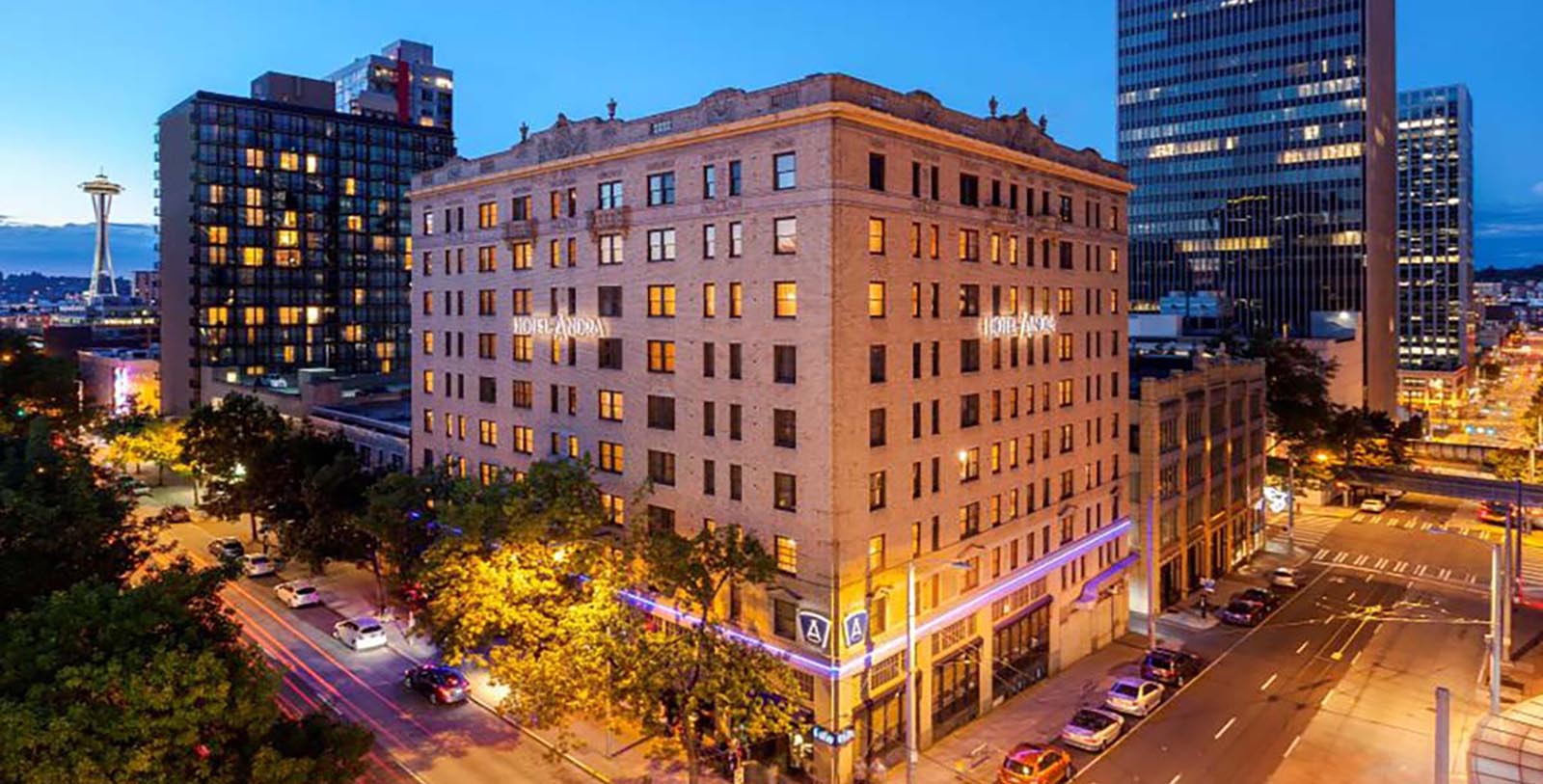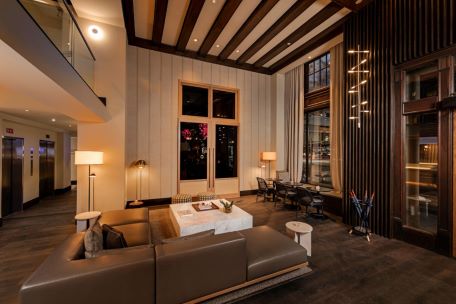Receive for Free - Discover & Explore eNewsletter monthly with advance notice of special offers, packages, and insider savings from 10% - 30% off Best Available Rates at selected hotels.
hotel Ändra's history
Discover the Hotel Ändra Seattle MGallery Collection, which once operated as a transfer station for the Women’s Army Corps (WAC) during the era of World War II.
VIEW TIMELINEUnlike the rest of the United States in the 1920s, Seattle, Washington, was already in a full-blown depression. Well-known for its boom-or-bust economic cycles, the city had fallen on hard times when its resident shipbuilders lost their defense contracts after World War I. Unemployment skyrocketed across Seattle as its wharves went dormant. It was within this environment that today’s Hotel Ändra Seattle MGallery Collection made its debut. Opened as the “Claremont Hotel” by Stephen Berg in 1926, the brand-new building entertained hundreds of weary guests every night. Mostly local in origin, the visitors yearned to find a place to relax and escape the financial turmoil unfolding around them. The Claremont Hotel thus became a popular social gathering spot in downtown Seattle, with its ninth floor serving as the focal point for all kinds of thrilling entertainment. Home to a series of long-term rental apartments, amateur musicians often used the ninth floor as a makeshift theater for impromptu jazz concerts that lasted well into the early morning twilight. But as Seattle’s fortunes began to brighten amid World War II, so did the atmosphere inside the Claremont Hotel. Indeed, the building was soon hosting countless individuals assigned to help revive the city’s underused drydocks for another round of military production. The Claremont Hotel even helped support the national war effort directly, operating as a transfer station for the important Women’s Army Corps. Formed in early 1942, the Women’s Army Corps was the women’s branch of the U.S. Army and had active-duty status during WWII. (Their previous iteration, the WAAC, was an auxiliary branch.) They provided a variety of support programs for the U.S. Army that ranged from mechanics to medical services to cryptography.
The Claremont Hotel continued to be prosperous for many years thereafter, although the rental apartments were eventually shuttered during the 1970s. Nevertheless, the hotel underwent a true rebirth after an imaginative hotelier named Craig Schafer acquired it in 2002. Falling in love with the location, Schafer determined to remake the layout to give a refined boutique experience. Investing millions, Schafer and his talented team of architects transformed the hotel’s footprint over several months. Gorgeous Scandinavian-inspired motifs appeared throughout the interior as part of Schafer’s desire to further connect the hotel to Seattle’s history, specifically its rich Nordic heritage. (Scandinavian immigrants had settled the greater Puget Sound region in the late 19th century, finding its familiar landscape and climate comforting.) Schafer even relied exclusively on wood and stone to better incorporate the rustic ambiance of the Pacific Northwest into the building’s renewed identity. When the project finally concluded two years later, the location triumphantly reopened as the upscale “Hotel Ändra” to great acclaim. The new name was Schafer’s homage to the restoration, with the Swedish word “ändra”—meaning “change”—reflecting its incredible journey up to that point. Now known today as the “Hotel Ändra Seattle MGallery Collection,” this fantastic historic hotel continues to be a cherished local landmark. Staying true to its Scandinavian theme, Hotel Ändra Seattle – MGallery Hotel Collection’s 123 fantastic guestrooms offer a distinctive coziness that embody the Danish concept of hygge. The hotel has also emerged as a top culinary destination in Seattle, thanks to the efforts of chef Tom Douglas. Not only has Chef Douglas helped curate the hotel’s culinary offerings, he has also overseen the growth of an innovative cooking school on-site known as the “Hot Stove Society.”
-
About the Location +
The founding of Seattle dates to 1851, when nearly two dozen Euro-American pioneers arrived from Illinois to settle Alka Point. Led by Arthur A. Denny, those families are known to history as the “Denny Party.” Their small community was the first non-Native American settlement in region, which primarily harvested timber from the surrounding forest. But the water surrounding Alki Point proved to be too shallow to accommodate the commercial vessels that transported the lumber. The pioneers thus relocated a few miles to the north along Puget Sound, specifically at the mouth of the Duwamish River near Elliot Bay. Shortly thereafter, those settlers were joined by another group under the direction of David Swinson Maynard who many referred to as “Doc.” Maynard’s group set up just south of the Denny Party, and over time, those two communities melded together. Right next to the village was also a vibrant community of local Duwamish Indians governed by a “Chief Seattle.” The two groups formed a close bond that proved to be beneficial over the next decade. In honor of the chief, the settlers eventually called their settlement “Seattle.” The name stuck, even after the Territorial Legislature formally incorporated the community in 1869. Logging remained the dominant industry within the community, with a steam-powered sawmill serving as its main venture. The village grew slowly at first, with Scandinavian immigrants from America’s East Coast constituting the majority of the new arrivals.
Nevertheless, the community’s population exploded when the Northern Pacific Railway arrived in nearby Tacoma. This development was further augmented when a second railroad—the Great Northern Railway—established an actual terminus within the city limits. Seattle’s population rose from around 3,500 in 1880 to more than 80,000 some two decades later. The railroads also transformed the city into a major hub for trade in the western United States, rivaling the likes of San Francisco in its commercial importance. Some 50 miles of wharves emerged in the heart of Seattle, which turned the area into a bustling seaport. The development of its waterfront even caused countless miners to use it as their main supply depot for the Klondike Gold Rush of the 1890s. Its metamorphosis into an international trading center spawned rapid urbanization, too, as all sorts of businesses quickly appeared for the first time. Seattle earned a reputation for being an “open city,” in which saloons and casinos dominated the local landscape. But as the city evolved more into a modern city, its politicians became increasingly concerned about its long-term future. Several activists within the early 20th-century Progressive Movement eventually drove out the officials who embraced the “open city” policies. In their wake, they instituted strict prohibitions against alcohol consumption and other “illicit” activities through the 1930s. But the progressives also made headways in such arenas like affordable housing and women’s suffrage. Nevertheless, the local Progressive Movement eventually ended right as the Great Depression began to start.
The city was able to lift itself out of the financial crisis, thanks in large part to the expansion of the defense industry in the years leading up to World War II. Seattle was a key manufacturer for the American war effort, producing all kinds of material for the military. The city itself was home to several major defense contractors, too. The greatest among those companies was Boeing, which created thousands of planes at its Seattle and Renton factories. Another business—the Seattle-Tacoma Shipbuilding Corporation—employed some 33,000 people, who churned out countless ships during the war. By the late 20th century, Seattle had become one of the most economically vibrant destinations in the world. Supplementing this growth was the emergence of several prominent technological firms. Many high-profile names within the industry established a significant presence in the city, such as Amazon, Microsoft, and Nintendo of America. Those businesses attracted talent from around the world, which saw Seattle’s population grow to two million people by the 1990s. The infusion led to a cultural proliferation that saw Seattle become a center for art and knowledge. Among the most famous trends to appear within the city currently was modern-day American alternative rock music. Seattle is now a celebrated destination among travelers the world over. It is one of America’s fastest growing cities in terms of its size and economy. But Seattle is also among the nation’s most diverse, as it has large demographics of people from across the globe. Few places in the United States can claim the cultural liveliness that defines Seattle today.
-
About the Architecture +
Despite its location in Seattle, theHotel Ändra Seattle MGallery Collection stands today as a brilliant, historic example of Chicago Commercial-style architecture. Commonly known as “Chicago School,” this unique architectural form first emerged in America’s Windy City at the height of the Gilded Age. While no actual “school” existed that taught the aesthetic, historians today agree that a common set of design principles unified the city’s architects around the turn of the 20th century. Among the most well-known features of Chicago Commercial-style buildings involved the use of steel frames clad in masonry (usually terra cotta). The reliance upon steel and durable masonry came about following the aftermath of the Chicago Fire of 1871, when most of the city’s preexisting structures were destroyed in the calamity. The building materials also allowed architects to install many large plate-glass windows throughout the façade. Called the “Chicago window,” the fixtures consisting of three parts centered along a panel that was flanked by two smaller sash windows. The arrangement resembled a grid, in which some spaces projected out from the exterior and formed additional bay units.
Nevertheless, the architects within the Chicago Commercial-style school of thought believed that their buildings should reflect the prosperity and technological progress of the Industrial Revolution. The structures thus borrowed several powerful aspects of Neoclassical architecture. Chicago Commercial-style skyscrapers were typically divided into the three distinctive sections that have historically formed what is known as the “classical column.” The lowest parts of the building acted as the base, where the most ornate architectural elements appeared. Much of the detailing occurred around the entryways, as well as any nearby windows. The middle floors of the structure often featured far less detail, which functioned as the “shaft” of the column. The grand ornamentation returned toward the final two stories though, creating what architects called the “capital.” The “capital” was typically defined by its flat roof and brilliant cornice, as well. Many buildings across Chicago brilliantly encapsulated this architectural approach, such as the Reliance Building, the Chicago Building, and the Rookery Building. The style’s popularity rapidly appeared in other cities, too, including a rapidly industrializing Seattle, Washington.

































